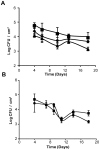Legionella pneumophila persists within biofilms formed by Klebsiella pneumoniae, Flavobacterium sp., and Pseudomonas fluorescens under dynamic flow conditions
- PMID: 23185637
- PMCID: PMC3503961
- DOI: 10.1371/journal.pone.0050560
Legionella pneumophila persists within biofilms formed by Klebsiella pneumoniae, Flavobacterium sp., and Pseudomonas fluorescens under dynamic flow conditions
Abstract
Legionella pneumophila, the agent of Legionnaires' disease pneumonia, is transmitted to humans following the inhalation of contaminated water droplets. In aquatic systems, L. pneumophila survives much of time within multi-organismal biofilms. Therefore, we examined the ability of L. pneumophila (clinical isolate 130 b) to persist within biofilms formed by various types of aquatic bacteria, using a bioreactor with flow, steel surfaces, and low-nutrient conditions. L. pneumophila was able to intercalate into and persist within a biofilm formed by Klebsiella pneumoniae, Flavobacterium sp. or Pseudomonas fluorescens. The levels of L. pneumophila within these biofilms were as much as 4 × 10(4) CFU per cm(2) of steel coupon and lasted for at least 12 days. These data document that K. pneumoniae, Flavobacterium sp., and P. fluorescens can promote the presence of L. pneumophila in dynamic biofilms. In contrast to these results, L. pneumophila 130 b did not persist within a biofilm formed by Pseudomonas aeruginosa, confirming that some bacteria are permissive for Legionella colonization whereas others are antagonistic. In addition to colonizing certain mono-species biofilms, L. pneumophila 130 b persisted within a two-species biofilm formed by K. pneumoniae and Flavobacterium sp. Interestingly, the legionellae were also able to colonize a two-species biofilm formed by K. pneumoniae and P. aeruginosa, demonstrating that a species that is permissive for L. pneumophila can override the inhibitory effect(s) of a non-permissive species.
Conflict of interest statement
Figures




Similar articles
-
Biofilms: the stronghold of Legionella pneumophila.Int J Mol Sci. 2013 Oct 31;14(11):21660-75. doi: 10.3390/ijms141121660. Int J Mol Sci. 2013. PMID: 24185913 Free PMC article. Review.
-
Replication of Legionella pneumophila in floating biofilms.Curr Microbiol. 2007 Nov;55(5):435-40. doi: 10.1007/s00284-007-9006-7. Epub 2007 Aug 23. Curr Microbiol. 2007. PMID: 17713816
-
Disinfection of bacterial biofilms in pilot-scale cooling tower systems.Biofouling. 2011 Apr;27(4):393-402. doi: 10.1080/08927014.2011.577525. Biofouling. 2011. PMID: 21547755 Free PMC article.
-
Effect of bacterial interference on biofilm development by Legionella pneumophila.Curr Microbiol. 2008 Dec;57(6):532-6. doi: 10.1007/s00284-008-9237-2. Epub 2008 Sep 4. Curr Microbiol. 2008. PMID: 18769851
-
Factors Mediating Environmental Biofilm Formation by Legionella pneumophila.Front Cell Infect Microbiol. 2018 Feb 27;8:38. doi: 10.3389/fcimb.2018.00038. eCollection 2018. Front Cell Infect Microbiol. 2018. PMID: 29535972 Free PMC article. Review.
Cited by
-
Biofilms: the stronghold of Legionella pneumophila.Int J Mol Sci. 2013 Oct 31;14(11):21660-75. doi: 10.3390/ijms141121660. Int J Mol Sci. 2013. PMID: 24185913 Free PMC article. Review.
-
Differential Bacterial Predation by Free-Living Amoebae May Result in Blooms of Legionella in Drinking Water Systems.Microorganisms. 2021 Jan 15;9(1):174. doi: 10.3390/microorganisms9010174. Microorganisms. 2021. PMID: 33467483 Free PMC article.
-
Legionella pneumophila response to shifts in biofilm structure mediated by hydrodynamics.Biofilm. 2025 Jan 24;9:100258. doi: 10.1016/j.bioflm.2025.100258. eCollection 2025 Jun. Biofilm. 2025. PMID: 39957834 Free PMC article.
-
Comparison of Legionella pneumophila and Pseudomonas fluorescens Quantification Methods for Assessing UV LED Disinfection.ACS ES T Water. 2023 Nov 1;3(11):3667-3675. doi: 10.1021/acsestwater.3c00428. eCollection 2023 Nov 10. ACS ES T Water. 2023. PMID: 37970541 Free PMC article.
-
Genomic characterization of a large outbreak of Legionella pneumophila serogroup 1 strains in Quebec City, 2012.PLoS One. 2014 Aug 8;9(8):e103852. doi: 10.1371/journal.pone.0103852. eCollection 2014. PLoS One. 2014. PMID: 25105285 Free PMC article.
References
-
- Hicks LA, Garrison LE, Nelson GE, Hampton LM (2011) Legionellosis – United States, 2000–2009. MMWR 60: 1083–1086. - PubMed
-
- Edelstein PH, Cianciotto NP (2010) Legionella. In: Mandell GL, Bennett JE, Dolin R, editors. Principles and Practice of Infectious Diseases, 7th ed. Philadelphia: Elsevier Churchill Livingstone. pp. 2969–2984.
-
- Li JS, OBrien ED, Guest C (2002) A review of national legionellosis surveillance in Australia, 1991 to 2000. Commun Dis Intell 26: 461–468. - PubMed
Publication types
MeSH terms
Substances
Grants and funding
LinkOut - more resources
Full Text Sources
Molecular Biology Databases

